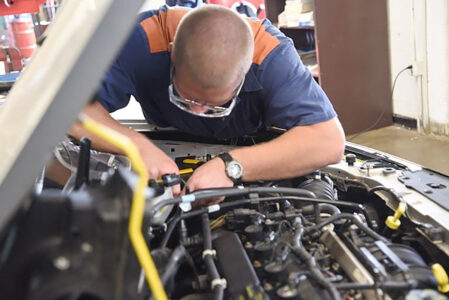Michigan prisons offer inmates an education
- A Michigan prison inmate in the automotive technology program works on a car engine. (Michigan Department of Corrections)
- Heidi Washington, the director of the Michigan Department of Corrections. (Michigan Department of Corrections)

A Michigan prison inmate in the automotive technology program works on a car engine. (Michigan Department of Corrections)
LANSING – Education opportunities have expanded in Michigan’s 26 prisons.
“Michigan leads the nation in the number of postsecondary education programs that we offer in prison,” said Heidi Washington, the director of the Department of Corrections.
In addition to helping prisoners earn high school diplomas, the department partners with post-secondary education institutions to offer licenses and certifications in various trades, along with associate and bachelor’s degrees.
The education programs have attracted attention from around the U.S., Washington said.
“We’ve had over half the states come to Michigan to study and understand what we’re doing in terms of education and vocational and post-secondary that’s working, and they are copying that,” she said.

Heidi Washington, the director of the Michigan Department of Corrections. (Michigan Department of Corrections)
Corrections is the biggest provider of adult education in the state, according to its website.
A combination of federal Pell grants, private grants and institutional funds cover inmates’ tuition, according to the department.
Washington said all instruction is carried out in person, and inmates must go through an application process.
Three prisons – Richard A. Handlon Correctional Facility in Ionia, Parnall Correctional Facility in Jackson, and Women’s Huron Valley Correctional Facility in Ypsilanti – contain “vocational villages” where inmates learn skilled trades in a specialized community setting.
Washington said commercial truck driving is one of the more popular offerings, and some inmates add related credentials such as auto or diesel mechanics.
To earn their commercial driver’s license, inmates complete the classroom and simulator portions of the training while incarcerated, according to the website. On-road training is conducted with one of the department’s trucking company partners after release.
Manufacturing-based programs, including machining and robotics, are also popular, Washington said, with more offerings on the horizon to support the state’s manufacturing industry.
At Michigan’s only women’s prison, cosmetology is “hands down” the most popular trade program, Washington said.
“We also have 3-D printing on the women’s side, which is a very difficult program, but the women are really excelling in it,” she said.
The programs also benefit local communities. For example, horticulture training programs contributed to a donation of more than 100,000 pounds of fresh produce to food banks, churches and other community institutions in 2025, according to a department press release.
For inmates pursuing college degrees, business and other entrepreneurial-type majors are popular, Washington said.
At Ionia’s Handlon Correctional Facility, Calvin University offers a bachelor’s degree in faith and community leadership and human services.
The program has granted 82 degrees so far, with 108 students currently enrolled and maintaining an overall grade-point average of 3.54 during the summer 2025 semester, according to the university website.
“A lot of people come into the prison system with, obviously, low education and attainment,” said Washington.
“They might come in with a sixth-grade educational level. What has been really cool has been to see them progress and get their GED and then their associate degree and actually get a bachelor’s degree.”
“A lot of these individuals didn’t think they were capable of achieving that level of education,” she said.
Providing inmates with education and skill-building opportunities helps them find steady employment after release, a factor in reducing future offenses.
Michigan’s recidivism rate – the rate of ex-inmates returning to prison within a three-year timeframe – has steadily decreased since 2005, with 2025’s rate of 21% being the lowest on record, according to the department.
“That’s the ultimate goal, right? To change the trajectory of people’s lives, and the most powerful thing education can do is stop the next generation from following in the footsteps of those who are incarcerated now,” said Washington.
———
This story was provided by Capital News Service at Michigan State University.







